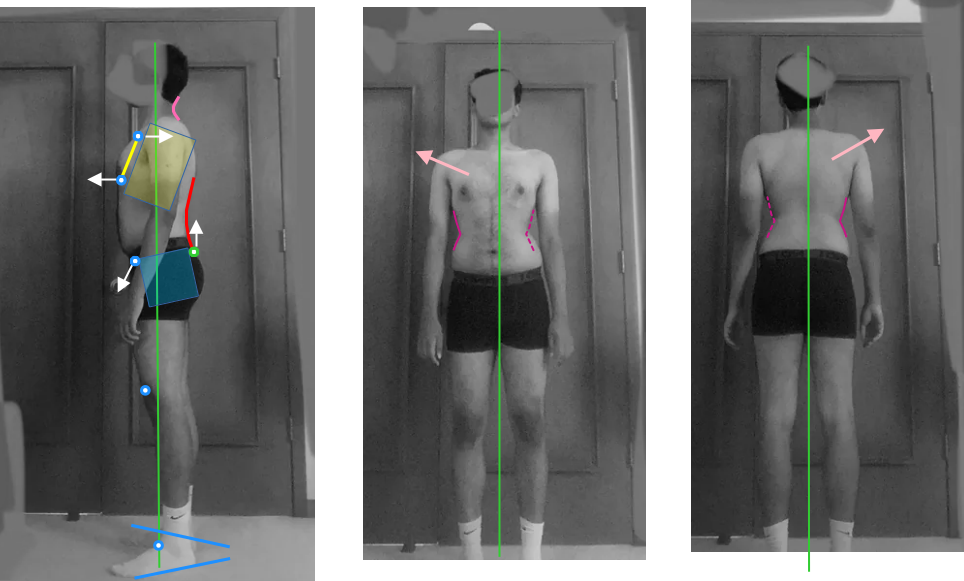Assessment context and image originals from this thread: https://www.reddit.com/r/PostureAssesments/comments/154992t/any_tips_on_how_to_fix_my_rounded_back/

Righto, so here is the assessment - all pretty standard deviation that most people suffer. Join the club.
Comment image
Lets' do it:
Feet are wrongly placed for standing. The blue lines (out steps) are converging at the back. They should be parallel instead.
Knees are released too forward (not in full extension).
Your pelvis (the blue square) is rotated - your iliacs, the blue spot at waist height (anterior superior iliac spine) are pushed forward and down while your sacrum (green spot) is lifted up. let's call this anticlockwise rotation of pelvis (as seen on the sagittal view). The pelvic rotation is indicated with the white arrows.
Ribcage (yellow rectangle) is rotated in the opposite way to the pelvis (clockwise). That is, the top of your ribcage is retracted back, and the bottom of it forward. again, you can see this on the slant of the yellow line (your sternum) which is actually the front part of your ribcage.
These two rotations when they happen together, they tend to produce the curvature in your lowerback (red curve) which is effectively shortening of your torso. By torso, we mean your ribcage + spine + pelvis, exluding everything else.
Because your torso is shortened in this way, to protect your sense of equilibrium, you are also retracting the mechanism of your arms backwards. This lifts your shoulders up too.
Head is also retracted back, which together with the arms is shortening your neck (pink curve). Your chin should be well and truly forward compared to your sternum.
All the blue points on the frontal plane should ideally be on the green plumb line.
You mentioned the rounded back. It's important to understand what a reference, or a model of "good posture" is. The model we use is defined as "shape" of body that will mechanically perform the most efficiently. What we see is not it.
From our perspective, you would want to have the red curve completely straight in the lowerback up to about the height of your armpits. Above that, you actually want to have what we call "the hump". That is curvature in your thoracic spine that should be there by design in order to get well performing mechanism.
This hump however, isn't the only thing we would want. Most importantly, you would first want to organise the torso in such a way to straighten the lowerback spine, and when you do that, you would get the "hump" as a result of that (and your head going forward and up).
To get back to your feet, I can't really see them on the anterior / posterior view, so placing the plumb line was challenging. I would rather take it as an educated guess, than a fact. For a fact, we would need to see your feet.
Either way, the pics show the left and right imbalances, again due to rotations in the different parts of your mechanism.
Yes, so because I can't see your heels to properly centre the plumblines, we are just guessing here.
But even without a plumbline, you see asymmetries in the mechanism. We should be symmetrical. Your habit is to place your left foot forward. Your iliacs aren't squared and again, all this needs to be compensated for due to equilibrium, so there are visible differences all the way up to your neck.
On the anterior view, I have placed the purple curve on your right side and then I mirrored the exact same curve to your left side (dashed line). You can see the shape of your left / right isn't matching.
I've done the same at the back view, but it's not as visible there.
All of the above is pretty common, however these postural habits aren't conducive to a proper functioning of your mechanism. You are restricting your circulation, breathing, digestion and you are stressing your joints in a way they shouldn't be stressed.
These are all postural habits of movement. It can be 100% changed with a conscious guidance and control of your movements (instead of habitual, subconscious control currently in place).
Hope that helps, hit me up if you have more questions or need clarification.